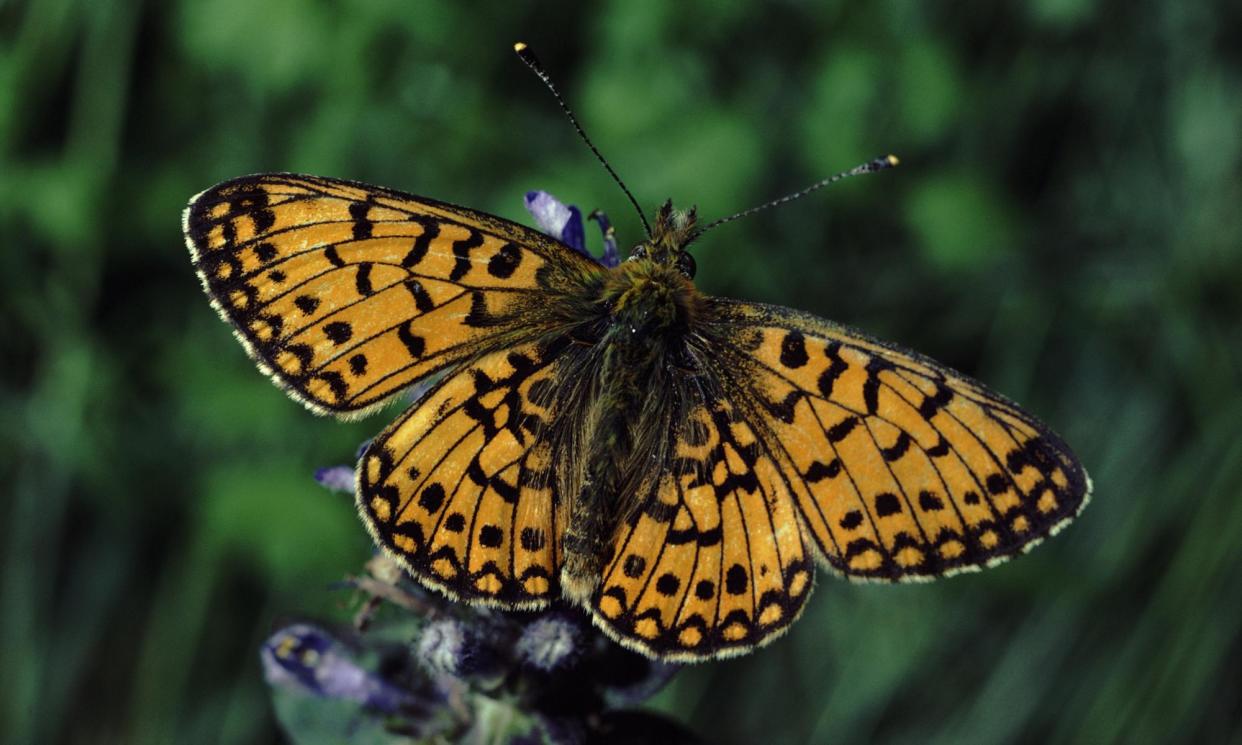Mass planting of marsh violets key to saving rare UK butterfly, says National Trust

A mass planting of marsh violets across England’s Shropshire Hills is to take place to try to prevent further decline of the small pearl-bordered fritillary or Boloria selene, a rare UK butterfly.
The small pearl-bordered fritillary’s distribution across the UK has plunged 71% since the mid 1970s and the species is now listed as vulnerable, according to the 2022 state of UK butterflies report.
It is hoped the planting will help increase habitats for the butterfly and other increasingly uncommon species including snipe, curlew and devil’s bit scabious flowers, the National Trust said.
Thought to have been plentiful until the 1950s, small pearl-bordered fritillary populations are believed to have been decimated by a combination of factors including global heating, which pushed colonies north and west in search of cooler climes, wetland drainage, which shrank habitats, and changing management techniques that allowed rushes to push out marsh violets, said Charlie Bell, a project manager at the National Trust.
Small pearl-bordered fritillary caterpillars are lovers of marsh violet leaves, Bell said. The adults lay eggs on the plant’s leaves. “The caterpillars hatch out into a ready-made buffet, they don’t really need the flowers.” The butterflies ignore the flowers too, feeding instead on nectar from other plants such as brambles, marsh thistles and ragged robin flowers, she said.
By planting the violets close to existing small pearl-bordered fritillary colonies, the project was aiming to increase the caterpillars’ food supply and reconnect isolated groups, she said. “There might be a few populations … then one gets wiped out and the distance between the remaining populations is too great for them to mix.” That situation left individual colonies isolated and vulnerable to extinction. “Ideally, there’d be lots of small populations and movement between them to keep them healthy.”
It was possible the butterflies might start laying this June or July, Bell said, but realistically it would probably be next summer before the insects would be seen using the new marsh violets.
The National Trust-led initiative aims to plant 20,000 marsh violets this year, with about 3,000 going into the ground today and more after the summer. “We are trying to see what works and learn lessons from this spring planting. We will be monitoring the plants so we can tweak our technique if we need to, for the autumn planting,” Bell said.
Others involved in the project are the Shropshire Wildlife Trust, Natural England, and the Shropshire Hills National Landscape Partnership, as well as landowners and volunteer planters.
Dave Wainwright, head of conservation for England at the charity Butterfly Conservation, welcomed the project, saying it was “on a scale that it needs to be, to really make a difference for the small pearl-bordered fritillary”. The trick, he said, was to find the conditions that suited the marsh violets and allowed them to survive. “This idea of connecting patches in the landscape is really crucial so if one patch becomes unsuitable then the butterflies have an alternative habitat,” he added,
John Tilt, of the West Midlands Butterfly Conservation group, also welcomed the project. “It’s a butterfly that’s quite common in Scotland but is now lost from the Malvern Hills and some of the rest of the West Midlands more generally. They are a very beautiful species,” he said.
Previously, he said, the fritillary species was helped by the once common practice of coppicing, or felling of some woodland trees, which let light in and helped to leave bare ground where marsh violets could thrive. The practice died out in the 1940s and 1950s, he added.


